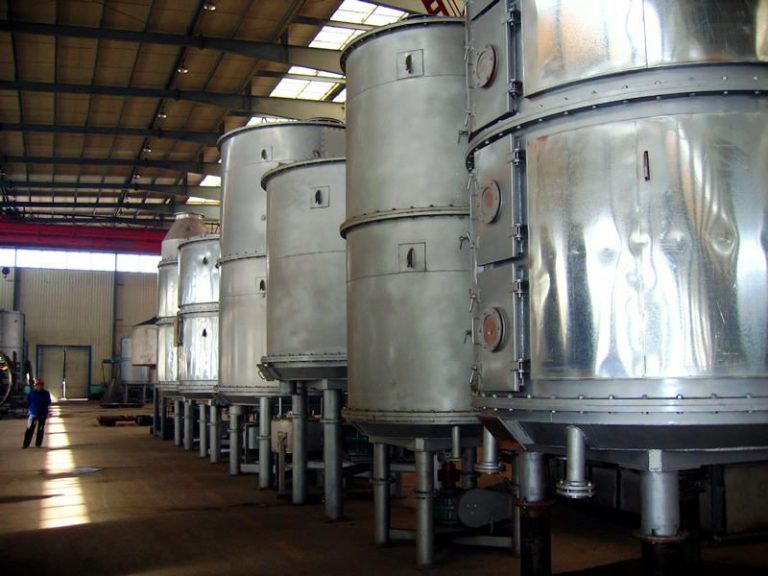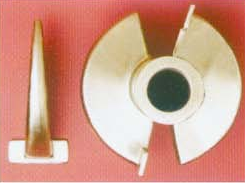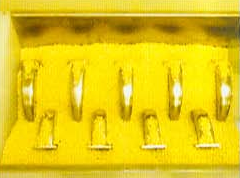Chemical Equipment
With drying, evaporation, crystallization, filtration, gas (vapor) liquid separation technologies and related chemical process engineering and equipment as the main products. We provide customers technical consultation and EPC services in the whole process of design, production, installation, commissioning, training, etc.
Our company provides a variety of sludge drying equipment and sludge drying tail gas treatment facilities such as double paddle dryer, horizontal plate dryer, continual plate dryer, film dryer, etc., which has extremely improved the sludge resource utilization condition.

Paddle dryer
Product description:
Paddle dryer is an indirect -heating drying equipment, it is suitable to dry good stable materials such as paste, powder, granule and sludge. It is capable of drying material with high moisture and high viscosity. It is characterized by the hollow rotating shafts and the hollow jacket. Copper oxide sludge is a kind of black cake type which is a bit sticky. We copper sludge is fed into the dryer through a screw feeder, and then is heated in the drying chamber in a high heating efficiency. Dry sludge is very fine powder and discharged through the airlock valve under the dryer. Evaporated moisture is taken out of the paddle dryer for dust collection in a bag filter.
Applications:
- For drying or cooling powder, small granule, filter cake and slurry materials; particularly good at drying sticky heat sensitive slurry materials continuously.
- Heating area: 1-200m2
- The drying chamber can be vacuum and normal pressure.
- Heat supply can be steam, hot water and hot oil.
Features:
- Dryer size is minimized, due to the large heat transfer area per volume.
- The wedge shaped paddles goes into the powder to enhance contact to the heat transfer area, and the heat transfer coefficient is relatively high due to the good mixing. So, high heating factor can be obtained. Also, the fullness of the materials is high as 80-90%, therefore large heat transfer area can be efficiently used.
- Since two shafts overlap each other, it prevents the adhesion of powder on the paddle wings, therefore keeping a good heat transfer.
- The residence time distribution is sharp and the powder is uniformly dried.Since the required carrier gas amount is small, the exhaust gas treatment system can also be minimized. This is a big advantage, especially for the closed system with inert gas circulation for solvent recovery.
- Slurry with high moisture content or materials with high viscosity can be treated.Available under
the vacuumed condition as well, for materials which are sensitive to high temperatures. - By using oil for the heat medium, it is possible to use high temperature up to 290℃.
- Drying and cooling can be done in one unit.
Technical advantages:
- High heat efficiency: The drying chamber is insulated by 50mm mineral wool and there is very little heat loss via the exhaust gas. The heat efficiency can reach 90%.
- Uniform drying: The specially designed wedge-shaped paddle can completely mix and stir the wet material to achieve very uniform heating. So the drying is very uniform.
- Continuous operation: Thanks to pneumatic ball valves for feeding and discharging under vacuum condition and the rotating paddles which can push the material forward, the drying process can be automatically and continuously.
- High evaporating rate: Under vacuum condition, the boiling point of moisture will be much lower as well as complete and uniform heat transfer, the evaporation rate is much higher than normal paddle dryer.
- Compact size: The drying chamber is very compact in size. Only need small installation space.
- Environment friendly: The evaporated moisture can be recovered by the condenser and buffer tank. The exhaust gas is from the vacuum pump is very little compared to normal dryer.
Structure of hollow stirring blade :
Inside of Paddle dryer:
Operation Principles:
- Atmospheric Drying Process:
1. Exhaust Blower 2. Precipitator 3. Mainframe 4. Air Filter 5. Heat Exchanger
- Solvent Recovery Drying Process
1. Mainframe 2. Precipitator 3. Condenser 4. Solvent Recovery Tank 5. Vacuum Pump 6. Vacuum Feeder Valve 7. Discharge Valve
Technical Parameters

Continual Plate Dryer
Product Description:
PG Series Continual Plate Dryer is a kind of high effective conducting and continuous drying equipment. Its unique structure and operating principle determine that it has advantages of high heat efficiency, low energy consumption, small occupying area, simple configuration, easy operating and control as well as good operating environment etc.
It can be widely used in drying process in the fields of chemical industry. Pharmaceuticals, agricultural chemicals, foodstuff, fodder, process of agricultural and sideline products etc. and is well received by various sectors in their practical usage. Now there are three big categories, named normal pressure, closed and vacuum styles; 1200, 2500, 2200 and 3000 size and so on; and three kinds of materials, namely A(carbon steel ), B(stainless steel used for those all part where materials are contacted) and C(on the basis of B to add stainless steel materials for vapor pipes, main shaft and support, and stainless steel linings for cylinder body and top cover).
With a drying area being from 4 to 180 square maters, now we have hundreds of models of series products and various kinds of auxiliary devices available to meet requirements of drying materials for customers.
Working principle:
The wet material is fed continuously to the first drying layer on the top of the dryer. It will be turned and stirred by rakes when the rake arm rotates and drop down to the outer edge of the large drying plate along the exponential helical line. The material will be moved from the small drying plate to its outer edge and drop down to the outer edge of the large drying plate underneath.
Both small and large drying plates are arranged alternately so the materials can go through the dryer continuously. The heat medium can be saturated steam, hot water or thermal oil. The heat will be led into hollow drying plates from one end and come out from the other end. The dried materials will drop from the last layer of the drying plate to the bottom of the dryer and then moved by rakes to the discharge outlet. The material moisture will be removed from the exhaust outlet on the top cover.
For the vacuum-type plate dryer, the moisture will be sucked out by the vacuum pump on the top cover. The dried materials will be discharged from the bottom layer. The drying capability can be improved if the dryer equipped with supplementary devices such as finned heater, condenser for solvent retrieval, bag dust remover, return and mix mechanism, draft fan, and etc.
Features of technology:
- Drying plate
Designing pressure: general is 0.4MPa, Max can reach 1.6MPa.
Work pressure: general is less than 0.4 Mpa, and Max can reach 1.6Mpa.
Heating medium: steam, hot water, Oil. When the drying plates’ temperature is 100℃, hot water can be used; when 100℃-150℃, it will be saturated water steam ≤0.4Mpa or steam-gas, and when 150℃-320℃, it will be oil. - Material transmission system
Main shaft revolution: 1-10 rpm, electromagnetism or frequency steeples speed regulating.
Harrow arm: There are 2 to 8 pieces arm that be fixed on the main shaft on each layer.
Harrow’s blade: spliced on the harrow arms, float together with the surface of the plate to keep contact. There’re several of types.
Roller: for the products easily agglomerate, or with the requirements of grinding, the heat transfer and drying process might be reinforced by placing roller(s) at the appropriate place(s) - Shell:
There’re three types for option: normal pressure, sealed and vacuum
Normal pressure: Cylindrical shell or eight prismatic types, with whole body and split structure. The main pipes of inlets and outlets of heating medium can be inside the shell, or outside the shell.
Sealed: Cylindrical shell could bear the interior pressure of 5Kpa, the main ducts of the inlet and outlet of heating media might be inside of the shell or outside.
Vacuum: cylindrical shell could bear the exterior pressure of -0.098Mpa. The main ducts of inlet and outlet is inside of the shell. - Air heater:
Normal used with the application of draft fan, in case the wet air enters, to increase drying efficiency.
Features:
- Easy control, wide application.
- Easy and simple operation.
- Low energy consumption.
- Good operation environment, solvent can be recovered and powder discharge meet the requirements of exhaust.
- Easy installation and small occupying area.
TRAJECTORIES OF MATERIAL
operational process:
①Damp Material②Dosing Unit ③Continual Plate Dryer ④Cold Air In ⑤Dried Product ⑥Heating Medium In ⑦Heating Medium Out ⑧Exhaust gas Evacuation ⑨Induced Draft Fan ⑩Fin Heater
①Damp Material②Dosing Unit ③Continual Plate Dryer ④Cold Air In ⑤Bag Filter
⑥Heating Medium In ⑦Heating Medium Out ⑧Dried Product ⑨Induced Draft Fan ⑩Fin Heater ⑪Exhaust gas Evacuation①Damp Material②Dosing Unit ③Continual sealer ④Continual Plate Dryer ⑤Condenser⑥Heating Medium In ⑦Heating Medium Out ⑧Solvent Receiver⑨Induced Draft Fan ⑩Dried Product ⑪Cooling Medium In ⑫Cooling Medium Out ⑬Exhaust gas Evacuation
①Damp Material②Dosing Unit③Continual Plate Dryer④Continual sealer⑤Dried Product⑥Heating Medium In⑦Heating Medium Out⑧Condenser⑨Solvent Receiver⑩Vacuum Pump ⑪Exhaust gas Evacuation ⑫Cooling Medium In ⑬Cooling Medium Out
Specification and Models




 1. Exhaust Blower 2. Precipitator 3. Mainframe 4. Air Filter 5. Heat Exchanger
1. Exhaust Blower 2. Precipitator 3. Mainframe 4. Air Filter 5. Heat Exchanger 1. Mainframe 2. Precipitator 3. Condenser 4. Solvent Recovery Tank 5. Vacuum Pump 6. Vacuum Feeder Valve 7. Discharge Valve
1. Mainframe 2. Precipitator 3. Condenser 4. Solvent Recovery Tank 5. Vacuum Pump 6. Vacuum Feeder Valve 7. Discharge Valve


 ①Damp Material②Dosing Unit ③Continual sealer ④Continual Plate Dryer ⑤Condenser⑥Heating Medium In ⑦Heating Medium Out ⑧Solvent Receiver⑨Induced Draft Fan ⑩Dried Product ⑪Cooling Medium In ⑫Cooling Medium Out ⑬Exhaust gas Evacuation
①Damp Material②Dosing Unit ③Continual sealer ④Continual Plate Dryer ⑤Condenser⑥Heating Medium In ⑦Heating Medium Out ⑧Solvent Receiver⑨Induced Draft Fan ⑩Dried Product ⑪Cooling Medium In ⑫Cooling Medium Out ⑬Exhaust gas Evacuation ①Damp Material②Dosing Unit③Continual Plate Dryer④Continual sealer⑤Dried Product⑥Heating Medium In⑦Heating Medium Out⑧Condenser⑨Solvent Receiver⑩Vacuum Pump ⑪Exhaust gas Evacuation ⑫Cooling Medium In ⑬Cooling Medium Out
①Damp Material②Dosing Unit③Continual Plate Dryer④Continual sealer⑤Dried Product⑥Heating Medium In⑦Heating Medium Out⑧Condenser⑨Solvent Receiver⑩Vacuum Pump ⑪Exhaust gas Evacuation ⑫Cooling Medium In ⑬Cooling Medium Out